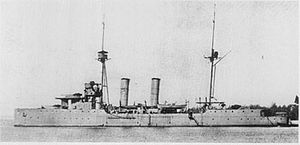HSwMS Clas Fleming

| |
| History | |
|---|---|
| Name | Clas Fleming |
| Namesake | Clas Fleming |
| Ordered | 17 May 1910 |
| Builder | Bergsund Finnboda, Stockholm |
| Launched | 14 December 1912 |
| Commissioned | February 1914 |
| Refit | New engines and armament 1939–1940 |
| Stricken | January 1959 |
| Fate | Sold for scrap 1960 |
| Badge |  |
| General characteristics (as built) | |
| Class and type | Clas Fleming class minelayer-cruiser |
| Displacement | 1,550 long tons (1,575 t) |
| Length | 80.2 m (263 ft 1 in) |
| Beam | 10.4 m (34 ft 1 in) |
| Draft | 4.3 m (14 ft 1 in) |
| Propulsion | 2 shaft Parsons steam turbines, 8 Yarrow-type boilers 6,500 ihp (4,847 kW) |
| Speed | 20 knots (23 mph; 37 km/h) |
| Complement | 161 |
| Armament |
|
| Armor |
|
HSwMS Clas Fleming was a mine cruiser of the Swedish Navy from World War I until the Cold War. She was named after the 17th century Swedish admiral Clas Fleming.
Commissioned in 1914, Clas Fleming was among the first Swedish warships to use Parsons steam turbines. As built it was armed with four 120 mm (4.7 in) guns in a superfiring arrangement: one at the forecastle, one - highly unusually - on top of its armoured conning tower, one on the poop deck, and a fourth at the stern. Up to 190 naval mines could be carried on the main deck. In service the stern was found to be very wet on rough seas, so in 1918-19 the poop deck was extended to the stern; the guns at the stern and on the conning tower were accordingly moved to a more old-fashioned, side-by-side positions just aft of amidships. In 1926 three 25 mm (0.98 in) anti-aircraft guns were added, one on the conning tower and two just behind the amidships 120mm guns.
In November 1939 Clas Fleming was extended with a 6-metre (20 ft) long new section to make room for four new six-cylinder two-stroke diesel engines; these however did not drive the propeller shafts directly, but were gas generators for the turbines, a rare arrangement never before used on a ship. Of the eight original coal-fired boilers only two were retained, and these were modified to oil firing.
After World War II Clas Fleming was placed in reserve in Stockholm, and was decommissioned on 1 January 1959.
Bibliography[]
- Gardiner, Robert; Gray, Randal, eds. (1985). Conway's All the World's Fighting Ships: 1906–1921. Annapolis: Naval Institute Press. ISBN 0-85177-245-5.
- Harris, Daniel G. (2004). Preston, Antony (ed.). Minelayer Clas Fleming: An Early Gas Turbine Ship. Warship. Vol. 2004. London: Conway Maritime Press. pp. 92–98. ISBN 0-85177-948-4.
- Cruisers of the Swedish Navy
- Ships built in Stockholm
- 1912 ships
- European naval ship stubs
- Swedish history stubs